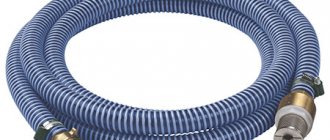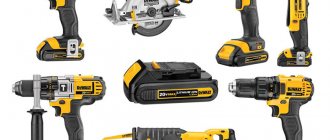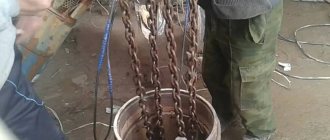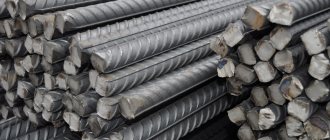The onset of cold weather does not always end the summer season in the garden. In private homes, as a rule, work is in full swing all year round. Often the home owner has the problem of choosing a hose made of frost-resistant materials that will not break in the cold and will last for quite a long time. This article will discuss such products and the subtleties of their selection.
Reinforced watering hoses
At a summer cottage, all activity does not always stop with the onset of cold weather, but in a private house, work continues even with the onset of the most severe frosts. Therefore, reinforced or rubber watering hoses with frost-resistant properties are always needed. They do not deform in winter and will last for several seasons. How to choose such an accessory?
What material are frost-resistant hoses made of?
Material is a key criterion for choosing a product. The stores mainly offer accessories made of frost-resistant rubber or plastic. Rubber hoses are flexible and do not freeze in the cold. Winter models consist of 4 layers, so they are quite heavy, but can withstand serious pressure. Their service life is more than 10 years.
Reinforced plastic watering hoses are made of several layers of PVC, one of which is dark. It is needed to protect the water in the hose from exposure to ultraviolet radiation. Otherwise, algae will grow inside the hose in the summer. The three-layer reinforced hose can withstand pressure up to 10 bar. At low temperatures it increases rigidity, but does not deform or crack.
Products made from silicone and single-layer rubber are not suitable for winter use.
How to insulate a pipe on the street
This article will be useful to those who plan to make protection with their own hands.
It is recommended to pay no less attention to the issue of well insulation than to its construction and final finishing. This is very important for places where optimal living conditions directly depend on the quality of the creation of such structures. Therefore, it is recommended to think through all the nuances at the design stage, especially since one part of the structure is located on the street and the other in the ground. The main stage is the insulation of the well even when installing the water supply system. In this regard, it is extremely important to correctly select the necessary components.
Materials
At a minimum, the main task of protection is to prevent moisture from penetrating pipes and floors and maintaining the temperature of their carrier. Among the most popular materials, penoizol, glass wool, polystyrene and basalt wool should be noted. They are excellent for harsh operating conditions of the water supply system, where there are cold winters and soil freezing of two meters or more. The cost of the work carried out varies and depends on the type of insulation chosen.
Mineral wool with foil side
There is also a more budget-friendly option for protecting the cold water supply, which you can actually do with your own hands. To do this, it is enough to use natural available elements, the price of which is more than affordable. We are talking about sawdust, straw, peat and leaves. Insulating plastic or metal pipes with their help will be as easy as shelling pears, having first completed the preparatory work to protect them from rot.
Protection process
A trench is made along the perimeter of the well, up to 2000 mm deep, and no more than 1400 * 1400 mm wide. Next, wooden formwork is installed. Its outer part is covered with earth, and its inner part with insulation. Expanded clay, leaves or sawdust can be used as the latter. The upper part of the floor is carefully compacted. The design for insulation from water is treated with a special water-repellent paint.
Installation of formwork
The plumbing system can also be finished with a galvanized box, for which tin sheets are tightly tied around concrete rings. Insulating components are poured into the existing voids.
Proper insulation of a well is possible only with strict adherence to the technology for performing the work. Below are the main points that are worth going into in more detail.
Hose stiffness
No less important criterion than the material is the rigidity of the hose. If a product is purchased for pumping water from a well or borehole, you need to choose a model that retains its shape well when the internal pressure changes. The hose must be as rigid as possible, resistant to collapse and squeezing.
Manufacturers achieve rigidity in three ways:
Modifications are available with braiding to prevent twisting. There are models with an internal spiral. These are the most durable hoses that last for many years in a row even in severe frost.
The spiral and reinforcing layer are made of synthetic materials. They increase the weight of the product and increase the cost, but such an additive increases the service life. Reinforced hoses are resistant not only to frost, but also to crushing, and are suitable for supplying and pumping water from a well or borehole in winter, filling skating rinks and slides. Most often they go on sale in coils of 50 m. Their diameter ranges from 25 to 100 mm.
A high-quality, durable and fairly lightweight frost-resistant hose greatly facilitates work in the country and in the garden. This product will be useful to every owner.
Source
Purpose
Today, such products are used both for watering the garden and for other purposes.
- For example, some of the varieties are used for filling a skating rink , others are needed for carrying drinking water.
- Some options are used for pumping petroleum products , as well as various types of oils.
- You can use a frost-resistant hose to clean the sewer . In addition, these products have found application for firefighting needs , and they are also used by vacuum cleaners.
A hose that does not stiffen from cold water.
Because You are not logged in. To come in.
Because you are not a trust user. How to become a trustee.
Because The topic is archived.
Because You are not logged in. To come in.
Because you are not a trusted user (phone number is not verified). Enter and confirm your phone number. Read more about trusts.
Because The topic is archived.
Because You are not logged in. To come in.
Because you are not a trusted user (phone number is not verified). Enter and confirm your phone number. Read more about trusts.
Because The topic is archived.
Because You are not logged in. To come in.
Because you are not a trusted user (phone number is not verified). Enter and confirm your phone number. Read more about trusts.
Because The topic is archived.
Because You are not logged in. To come in.
Because you are not a trusted user (phone number is not verified). Enter and confirm your phone number. Read more about trusts.
Because The topic is archived.
Because You are not logged in. To come in.
Because you are not a trusted user (phone number is not verified). Enter and confirm your phone number. Read more about trusts.
Because The topic is archived.
Because You are not logged in. To come in.
Because you are not a trusted user (phone number is not verified). Enter and confirm your phone number. Read more about trusts.
Because The topic is archived.
Because You are not logged in. To come in.
Because you are not a trusted user (phone number is not verified). Enter and confirm your phone number. Read more about trusts.
Because The topic is archived.
Because You are not logged in. To come in.
Because you are not a trusted user (phone number is not verified). Enter and confirm your phone number. Read more about trusts.
Because The topic is archived.
Because You are not logged in. To come in.
Because you are not a trusted user (phone number is not verified). Enter and confirm your phone number. Read more about trusts.
Because The topic is archived.
Because You are not logged in. To come in.
Because you are not a trusted user (phone number is not verified). Enter and confirm your phone number. Read more about trusts.
Because The topic is archived.
The car holder for mobile phones VHM-12 allows you to securely mount the device on the dashboard ventilation grille. Price: 300 rub.
A business card with a dialed contact phone number. An original convenient solution for providing information. Easy to install on. Price: 325 rub.
The best wireless stereo headphones with cat ears Cat STN-28, a new product for stylish and advanced people! Bluetooth headset for cats. Price: 1,300 rub.
Source
Dimensions of flexible water connection
Flexible line length
Flexible hose diameter
Flexible hose thread diameter
For household appliances and faucets, the connection sizes are different: 3/8 inch or M 10 for connecting faucets , then there are fittings measuring 1/2, 3/4 and 1 inch for connecting the rest of the equipment and filter system.
All necessary dimensions and characteristics of the flexible hose are indicated on the packaging or on a tag attached to the hose. The designation M 10 , for example, denotes the internal diameter of a thread of 9.5 mm in the metric system of measurements (as you can understand, rounding is used for convenience, up or down, so instead of 9.5 mm for a 3/8-inch thread, we see designation M 10, or in other words conventionally 10 mm, this designation also has the name Euro size), 1/2 inches is designated as M 12 at 12.7 mm, and so on.
Conversion table inches - mm - euro size.
The best hoses for watering the garden 2022
Artificial watering is indispensable for the garden. Even when there is only a lawn on a country plot, it must be watered regularly. Getting watering hoses is the task of every owner. Not so long ago, this was a simple task - the hoses were rubber. Come and buy by the meter. Modern technologies do not stand still, and when you come to the store, you may be surprised by the assortment.
A hose is a hollow tube made of flexible material for transporting liquid. It is connected to a pump or water supply and distributes water throughout the area. It is necessary to select it according to technical parameters, as well as length. Go to the store prepared in all aspects of width, pressure and material of manufacture. And don’t forget to purchase adapters and connectors for connecting to garden pumps.
The editors of the YaNashla website have prepared a review of the best watering hoses for 2022.
Types of flexible water line
To connect water to a water consumer, two types of flexible lines are used:
Reinforced flexible liner
Reinforced flexible water supply hose.
Reinforced flexible hose is a flexible hose consisting of non-toxic rubber and covered on top with a reinforcing braid made of various materials. The mesh can be made of stainless steel, aluminum, galvanized metal or nylon braid . It is believed that a hose with nylon braid is guaranteed to fit any operating environment.
Bellows liner
Bellows liner hose.
Bellows flexible liners are steel rings that are seamlessly drawn or pressed under high pressure and welded together . The rings are made of stainless steel. Compared to rubber hoses with metal braiding, they are inferior in flexibility. Wall thickness is about 0.3 mm.
In the store: green, black, yellow
How to choose a hose in a store: by price, color or length? In large stores, popular models are sorted, each buyer has his own argument. All racks are laid out with neat bundles of multi-colored hoses.
Among them, lightweight, seemingly weightless models stand out. There are strong, heavy ones. You can immediately determine the durability of a product by looking at which ones will last for several years and which ones will be good for a couple of seasons. To care for plants, you need a pump that can withstand the pressure.
All technical parameters are indicated on the label for the hose. Managers often duplicate information on the price tag; the buyer immediately sees the main parameters. Not all hoses come in packaging; sellers unwind the required quantity from special equipment.
What should be on the label:
Let's look at some parameters in detail and find out whether the internal or external diameter size is indicated on the label and what reinforcement is.
Temperature standards for the heating system in an apartment building
The heating circuit in apartment buildings is built in cooperation with a centralized system to which the pipes are connected. Through them, the coolant is directed to the apartment building, where its further supply is regulated by inlet valves. After this, the water goes through the risers and eventually ends up in the radiators and radiators of each apartment.
The described processes, as well as everything related to the rules for providing the population with utility resources, are reflected in the Decree of the Government of the Russian Federation dated May 6, 2011 No. 354 “On the provision of utility services to owners and users of premises in apartment buildings and residential buildings” (hereinafter referred to as Decree No. 354). Heating quality requirements are set out in Section VI of Appendix No. 1 to the rules of Decree No. 354.
In addition, detailed rules for the provision of heating services are prescribed in the Order of Rosstandart dated June 11, 2014 No. 544-st “GOST R 51617-2014. National standard of the Russian Federation. Housing and communal services and management of apartment buildings. Public utilities. General requirements" (hereinafter - GOST R 51617-2014) and "GOST 30494-2011. Interstate standard. Residential and public buildings. Indoor microclimate parameters”, approved by order of Rosstandart dated July 12, 2012 No. 191-st (hereinafter referred to as GOST 30494-2011).
These acts establish the parameters of the coolant for the heating system of an apartment building. Thus, the temperature of the coolant (water) when supplied to the system is equal to the temperature of the water when it leaves the heating boiler. As a rule, the coolant should be brought to a temperature of 130-150 °C, but this indicator also depends on the outside temperature in the region.
Typically, the water leaving the boiler should have a temperature of 115 °C.
However, the standard temperature in the heating system can be within 95 ° C or 105 ° C (for different systems).
Next, to create comfortable conditions in the room, the proper condition of the parameters of the riser, which conducts water from the heating unit to the apartment, is ensured. They vary depending on the summer and winter seasons.
Of course, in practice, the temperature of the coolant in the riser depends on the operation of the thermal power plant and on heat loss on the way to the house. However, the riser temperature in winter should be in the range of 70-90 °C.
Additional technical specifications
The performance of the hose is affected by modern improvements. This is also something to pay attention to when purchasing.
Multi-layering
A single-layer hose is the thinnest, the casing has no additional internal or external layers. They do not tolerate climate change and are not resistant to changes in water pressure. Used and stored at positive temperatures. It is mainly used for short transfers of water: from a barrel to a bucket.
Multilayer hoses are durable, yet flexible and wear-resistant. Resistant to ultraviolet radiation and increased operating pressure. But at the same time they are quite elastic and curl well. They pass a large volume of water, which allows you to water a large number of garden crops.
Reinforcement
Rubber or silicone plastic pipes, into the walls of which reinforced threads made of polymers or steel are soldered to increase wear resistance and withstand high pressure. Frost resistance increases, but at the same time the weight of the hose increases. Well suited for summer stationary water supply, when the water supply is extended over the entire area during the summer and is removed with the onset of persistent cold weather.
The most durable reinforced hoses can withstand pressures of up to 40 bar. When choosing, you need to pay attention to the size of the cells - the smaller they are, the stronger the hose.
Expandable hose
An innovative invention of recent years. Unique hose-in-hose design. The inner layer is made of rubber and has high stretchability. The second, outer layer is made of nylon, designed to limit the stretching of the inner layer.
When filled with water, the hose increases in volume and passes a large volume of water through itself. After turning off the pump, all the water flows out and the hose shrinks in size to its original size. It is very light weight and has an interesting design. It is becoming increasingly popular among buyers.
Pipe diameter
Hoses have an interesting pattern: the longer, the narrower the diameter should be. If the hose is connected to a water tap, the diameter should be slightly smaller, it should be easy to put on the tap and not fall off when pressure is applied.
The most common diameters are ½ – 13 mm. and ¾ – 19 mm. The largest is 1 1/2 - 38 mm. The diameter of water pipes in Russia is measured along the inner rim.
Buyers mistakenly choose large-diameter hoses, thereby assuming that more water will flow through. In fact, you can get the opposite result - with low pressure, watering will be very slow. The best choice is a durable hose with a medium diameter.
Operating pressure
The hose with a large number of layers and reinforcement can withstand high water pressure up to 40 bar. A single layer will withstand a pressure of 2 bar. On reinforced hoses, you need to pay attention to the fastening to the tap; at high pressure, the heavy hose will fly off.
Electricity
There are cases when the thickness of the water supply is only 20 mm, its length is about 50 meters, but the depth is about 80 cm (this is very small), and in places where excavation work is not recommended (on the roadway, for example). In such situations, utility services recommend waiting for a thaw - but this is not an option.
To defrost a plastic pipe in this case, you can use a homemade device. To assemble it, you need a plug for the socket, a two-core copper wire, a compressor and a hose for pumping out water. For our example, let's take a wire with a cross-section of 2.5-3 mm, an 8 mm car fuel hose and a car compressor or pump.
On a small section of the wire, the outer insulation is removed and the cores are separated. First, one of the wires is stripped of insulation, and the remaining insulated piece of wire is carefully bent in the opposite direction along the wire, trying not to damage the sheath. Now, almost at the bend, the wire is screwed with 3-5 tight turns of bare wire. Having retreated 2-3 mm from this place, the same manipulations are performed with the second core. Make sure that the ends of the two wires do not touch each other.
On the other side of the wire, a plug and a “bulbulator” are attached. Such a unit supplies electric current directly to the water, resulting in a reaction that releases a large amount of heat. What is also ideal in this case is that only the water is heated, while the wires remain cold, which does not threaten accidental burns of polyethylene pipes.
So, we push the wire into the water supply, making sure that it does not bend, until it comes into contact with ice. Next, turn on the device for a couple of minutes and wait until the ice begins to melt. After this, you need to turn off the device and try to move the wire further away. In a similar way, first defrost one meter of water supply.
Now it’s time to remove melt water from the pipe using a compressor to reduce the volume of heated water and avoid re-freezing of the pipe. If you have special equipment, you can weld a faucet onto the pipe, which can be closed as soon as water flows through the pipe. This will allow you to avoid flooding the work area with the plug and not pull the wire out of the pipe.
Recommendations for care and use
When buying something, you need to know how to use it correctly. In summer, all hoses can be left on the ground, if they do not interfere with the passage, the best option would be shade. Manufacturers recommend storing them rolled up. On a shelf or special device.
It is easy to wind onto coils or reels, and many operate automatically. They don’t take up much space and are always available for watering. There are options on wheels; after rolling, you can simply roll it away to a storage location.
Storage Features
Proper storage must be organized so that there is no damage, severe bends, and the organization of the correct temperature regime is also important.
The hose is twisted only after the water has completely drained. Check along the entire length and then start rolling. You can lightly bandage it to make it easier to carry and transport to the wintering site.
It is advisable that the storage location in winter should have a positive temperature. At the dacha in winter you can store it in the cellar or take it to your apartment. Rubber hoses survive winter well in unheated rooms.
How to warm frozen water pipes 4 effective ways
When the outside temperature drops below normal and you notice that the water supply is frozen, do not rush to buy new pipes. There are proven ways to help you deal with this problem.
Using hot water
If you find or are 100% sure that a section of your water supply is frozen in an “open” place where you can use boiling water to heat the pipe, then use boiling water. Before doing this, take a rag and wrap the pipe around it. It will take all the water and increase the time the boiling water interacts with the pipe. Pour hot water until the ice completely melts. To speed up the process, you can turn on the tap.
Use a hair dryer
With the help of hot air from a hair dryer, the ice can be easily melted. Owners of such hair dryers recommend hanging plastic film over the heating pipe. This way, heat losses will be reduced significantly, which will allow the hair dryer to work more efficiently. You can also use a hair dryer with a steam generator.
Current
To do this, use a welding machine. To heat a pipe in this way, you need to connect one wire (plus) to one end of the pipe, and the second (minus) to the other end. In just a couple of minutes the ice will melt. The operating principle of this method is similar to a boiler. The advantage of using electric current is that only the water is heated. The transformer wires remain cold. This will prevent the plastic pipe from melting with the water. The downside of this method is that you need a transformer.
Find specialists
You don’t have to suffer on your own, but simply call professionals. They will have special means for warming up the ice. For example, a hydrodynamic installation. It cleans not only water pipes, but also sewer pipes. The installation supplies hot water under powerful pressure, from which the ice gradually melts. At high pressure, the ice in the pipe disappears very quickly.
Which method to choose is up to you. Consider your capabilities and ability to defrost the pipes yourself without incident. And if you doubt that you can do everything correctly, it’s better to call a specialist.
Rating of watering hoses 2022
Hoses have firmly entered into country life. In the areas you will not find wells with water raised manually. All around automated process. Summer residents buy new hoses every year, some for a new site, and some to replace an old, deteriorated model.
The rating is based on reviews on online forums and the number of purchases in stores. Buyers share tips on a successful purchase option, and also give recommendations on how to use a particular model.
The manufacturer always guarantees technical specifications, but everyone has their own needs. There should be no mistakes when choosing; after studying all the technical capabilities of the hoses, feel free to buy the right one.
According to buyers, an expensive hose for plant care is not always convenient for daily work. Which one is better to buy, let's look at the best manufacturers.
Hose diameter: ¾ (19mm.)
Operating pressure: up to 22 bar
The most popular size, suitable for most water taps. The optimal combination of diameter and length of the hose allows you to water large areas of the garden with good pressure. UV resistant. The manufacturer has a large line of reinforced hoses.
Hose diameter: ¾ (19mm)
Operating pressure: up to 15 bar
The hose comes in 2 sizes: 25 and 50 meters. The 3-layer reinforced hose is durable, easy to carry around the garden and can withstand good water pressure from a pump. Reinforced with nylon threads, can operate at sub-zero temperatures.
Price from: 980 rub., set - 2050 rub.
Hose diameter: 1/2″ 20
Operating pressure: up to 24 bar
Hose diameter: ¾(19mm)
Working pressure: 10 bar
A good 3-layer hose for summer water supply. It is portable throughout the garden, it is easy to buy adapters and connect it to both the pump and the water supply.
Working pressure: up to 10 bar
Operating pressure: up to 25 bar
High degree of wear resistance due to high-quality reinforcement. Long-lasting, durable and good length up to 50 m. Waters the entire garden in a matter of minutes. Withstands good pressure.
Tip 3 Melt the ice, don't heat the pipe
What if the water in a plastic pipe freezes? Here the above methods will be useless or even dangerous for the integrity of the pipeline. Therefore, it is worth taking a more careful route, which, by the way, is quite applicable to iron products. Before describing it, I will immediately note its main advantages:
- Absolute safety in relation to the pipes and the health of the person performing the defrosting process;
- High efficiency and clear results. The procedure may take quite a long time, but in the end you are still guaranteed success;
- Minimum financial costs. You may have to buy some things, but you definitely won’t need any expensive equipment;
- Ease of execution. You don’t need to have any special skills; it will be enough to accurately follow the instructions I provided below.
Sample of a suitable hydraulic level
Steel wire with a diameter from 2 to 4 mm. Calculate the length depending on how far the frozen place is from the point at which you penetrate the pipeline;
The simplest plastic bucket
- We take one of the ends of the hydraulic level and attach the edge of the wire to it so that the tube protrudes by 10 mm. You can simply wrap steel around the plastic, you can fix it with tape, the main thing is that the connection is strong and there are no sharp fragments sticking out of it that could damage the pipeline from the inside;
- We connect the other end of the measuring device to the outlet of Esmarch's mug;
- Now we begin to carefully push the edge that with the wire into the pipeline;
Scheme of implementation of the described procedure
In 60 minutes, this method can free up to 100 cm of pipeline and, as I noted above, without any significant risks.
There is also a way to destroy ice by inserting a bare wire into a pipe, but if you are an electrician, you yourself will guess how it works, and if not, then it will be too dangerous for you, which means it’s better not to focus on it at all
Expandable hoses
The stretch hose was placed separately in a separate category. Recently, this type of watering equipment has been gaining high scores in ratings. Buyers choose a convenient, lightweight format, both for use and for storage. Despite all the advantages, the price of stretchable hoses is very low.
Price from: from 700 rub.
Material: polyester woven fabric, elastic, plastic.
Working pressure: up to 16 bar
Blue, green, changing shape with the addition of water. Increases 3 times with water pressure. The hose comes complete for ease of use. It appeared very first on the market, but many hose manufacturers have now begun to produce a similar option.
Working pressure: up to 6 bar.
Working pressure: up to 5 bar.
Excellent quality is proven not only by the good performance of the hose, but also by the durable screw fastening to the water supply or sediment. Several watering modes: hard stream, shower, flat stream, center, cone, weak stream, aeration. Allows each plant to be watered with special care
How to find out the temperature of the coolant in the batteries
When doubts arise about the quality of the heating services provided, and the inhabitants of the apartment simply begin to freeze, measures should be taken to determine the cause. To do this, measure the temperature:
- air in the room;
- pipes;
- batteries;
- coolant - water in the heating system.
The data obtained will help you understand whether the room is really unreasonably cold or whether it is just a subjective feeling.
It must be taken into account that independent measurements of heating indicators are not direct evidence of violation of standards. However, they can serve as a basis for filing a complaint and inviting representatives of the service organization for control measurements
Determining the water temperature in the central system
It should be noted that reliably measuring the temperature of the coolant in a central heating system is not so easy. The most accurate indicator remains only the air temperature in the room. However, you can do the following:
- Open the tap if it is installed on the radiator in the apartment.
- Place a container under it, after placing a thermometer there.
- Collect water.
- Wait for the final thermometer reading.
This indicator must comply with the described standards, but upward deviation from them is also allowed. The maximum temperature deviation is up to 4 °C.
In addition, if air is detected in the heating system of the apartment, you should contact the service organization.
Determining hot water indicators
There is another way to establish the truth, related to the fact that the temperature of the heating batteries in the apartment and the hot water supply are directly related. Therefore, it is advisable to measure the water degree like this:
- Open the hot tap.
- Wait 3 minutes for the water to heat up to maximum.
- Take a container and place it under the stream without closing the tap.
- Place the thermometer in the center of the container.
- Wait for the final readings from the device to be received.
If the device shows a number from 60 to 75 °C, everything is normal with the coolant. If the temperature data is lower, it is possible that the water in the heating system is not heated enough.
Conclusion
Hoses in a suburban area are necessary. How to use? For watering the garden, washing the car, the facade of the house, windows. Or you can splash around in the heat and have fun.
Errors when choosing will not arise if you carefully study all the information about the technical characteristics. When going to stores, you need to know how long the hose is needed and for what period you decide to purchase the hose. Where the hose will connect to the water supply or pump, be sure to find out the cross-section of the pipe. This will save you from going to the store again for additional adapters.
If you rented a dacha for one year, it is easier and cheaper to buy a single-layer one. For a long term it is necessary to buy a solid product. You can buy several different ones and see which one will work best on your site.
Country life should be easy and pleasant. Running around with watering cans and buckets is not for us. We choose the best hose and enjoy a fragrant garden and a luxurious vegetable garden. We transfer complex gardening chores to modern technology and enjoy nature.
Source
Tip 2 Use an artificial temperature increase against ice
Heating a pipeline from freezing with your own hands by increasing its temperature is only possible if it is made of metal. You will only damage the plastic structure. And taking into account the fact that frozen liquid tends to expand, it is advisable to react quickly before the pipes burst.
Whichever of the methods listed below you choose, you should follow some general rules to avoid unpleasant consequences of your activities:
- Before starting work
, open the water tap so that the melted water has somewhere to move; - Do not heat the frozen area from the middle
. After all, again, there will be no way out, and no one knows what this will lead to; - Heat the water supply system from the tap to the riser, and the sewage system, on the contrary, from the riser to the tap
. This will also ensure a controlled outflow of melt water; - First of all, examine the place of freezing, evaluate it and select the optimal warming method
.
Boiling water
This elementary and incredibly cheap method is suitable even for plastic products, since polypropylene pipes, which are least resistant to high temperatures, can withstand heating up to 90-100 degrees Celsius. But it has two important disadvantages:
- Can only be applied to open sections of the pipeline. If crystallization occurred, for example, underground, then you simply won’t get there with a kettle;
- Low efficiency. Frankly speaking, there is little benefit from pouring boiling water over pipes. Unless we are talking about a very small ice plug in a thin product.
Blowtorch or industrial hair dryer
The action plan here is simple:
Turn on the device; We methodically move an outgoing stream of hot air or flame over the frozen area, observing all the above precautions.
The efficiency in this case, of course, increases significantly in comparison with the method described above, but access is still limited only to visible gaps in the highway.
Electricity
If you took the trouble to install a heating cable at one time, then to remove ice from the pipeline using electricity you will only need to turn on the appropriate toggle switch. But if you haven’t done this, then you need to get a welding machine somewhere and make the pipe itself a heating element. After all, everyone remembers that metal heats up when an electric current passes through it?
The instructions for defrosting the object in this case will be more complex:
- We connect the terminals to the edges of the proposed ice plug. It is noteworthy that here it is enough to have only some points of the pipeline open, and not the entire freezing zone, which significantly expands the capabilities of the described method;
- We set the power on the regulator to the minimum;
- We click the power switch and let the device work for thirty seconds;
- Then turn it off for a minute to let the equipment “rest.” Burning it down is a simple matter, but very expensive;
- We repeat the procedure several times. If there is no overheating of the pipe during the process, then the power can be increased;
- After thawed water begins to drip from the tap, we warm it up a few more times, and then turn off the device completely. It is not at all necessary to completely melt the ice; it is enough to make a gap in it so that the rest can be completed by the water flow;
- You should not close the tap for a while longer in order to clean the pipeline as best as possible from any remaining icing.
Rating of the best watering hoses
When compiling the TOP 8 best hoses, we were guided by the selection criteria described above and the cost of goods. Experts also studied customer reviews, which helped form an unbiased opinion. In the review you can see both the pros and cons of the models, and this will help you make an informed choice.
| Nomination | place | Name of product | price |
| Rating of the best watering hoses | 1 | HOZELOCK Tricoflex Ultramax 3/4″ 25 meters | 3 790 ₽ |
| 2 | GARDENA FLEX 3/4″ 25 meters | 1 300 ₽ | |
| 3 | RACO Classic 3/4″ 50 meters | 1 500 ₽ | |
| 4 | GRINDA EXPERT 3/4″ 25 meters | 3 000 ₽ | |
| 5 | GARDENA Classic 3/4″ 20 meters | 2 900 ₽ | |
| 6 | PALISAD Professional 3/4″ 25 meters | 1 200 ₽ | |
| 7 | KARCHER PrimoFlex 1/2″ 20 meters | 1 390 ₽ | |
| 8 | CALIBER Aqua Line 3/4″ 25 meters | 1 300 ₽ |
HOZELOCK Tricoflex Ultramax 3/4″ 25 meters
Topping the list of the best is a hose with a length of 25 m and a flow diameter of 3/4 inch, which in terms of millimeters means 19. It is not difficult to put it on the gander of a regular tap with a “brush”, which is often used in courtyards at dachas. The flexible irrigation tube consists of an internal layer of PVC with micropores, created using Soft&Flex technology, which ensures rapid flow of liquid. Also, due to this design, the irrigation channel turned out to be 25% lighter than its competitors and can be simply wound into a reel. Three yellow ribs on the surface are not just decorative inserts, but take part of the load on themselves, preventing the rubber from breaking. In reviews, customers like the product due to the absence of heavy metals and phthalates, so it can be used not only for irrigation, but also for collecting drinking water.
The flexible pipe for irrigation is recognized as the best due to the presence of reinforcement using TNT technology. This involves weaving reinforcing fibers inside the rubber layer, which not only strengthens the walls of the hose, but also prevents it from twisting. If you often need to go around tree trunks or beds, then a regular hose may twist, blocking the flow of water. This will not happen with this product.
Advantages
Flaws
GARDENA FLEX 3/4″ 25 meters
Second place goes to a product from GARDENA with a 3/4-inch flow diameter and a length of 25 meters. The rubber channel for irrigation is reinforced inside and reinforced on the outside with three orange ribs that protect the structure from refraction. The manufacturer has endowed the rubber with resistance to UV rays, which allows you not to put the sleeve in the shade after watering. All components of the material are clean and the product is suitable for drinking water supply.
We rated the watering hose as the best for durability. The manufacturer assures that the channel will withstand pressure up to 25 bar (usually in a water supply up to 6 bar). Such reliability was achieved thanks to the use of carbon fiber used for tuning car bodies. This is true if you use a pump for irrigation that pumps water from a well or well. This hose will withstand any pressure surges. According to reviews, the product is of high quality and lasts an average of 7 years with active seasonal use.
Advantages
Flaws
RACO Classic 3/4″ 50 meters
If you have a large garden that needs watering, use a long 50 meter RACO Classic hose. This is a rubber tube with three layers and a flow diameter of 19 mm. It fits easily onto the tap and simply rolls up. Although its walls are thinner than its analogues, reinforcement is still provided inside, so the sleeve will not tear under pressure. The maximum permissible load is 20 bar. Despite its large length, the total weight of the reel is 9.6 kg, so it is not difficult to carry it in your hands to the garden. You can use the channel for watering even during the daytime, since the walls of the hose are resistant to UV rays, and the maximum temperature is allowed up to +50 degrees.
Advantages
Flaws
GRINDA EXPERT 3/4″ 25 meters
The watering hose has a thick outer layer. This, of course, affected the weight of the coil, but it allows it to withstand pressures of up to 30 atm. If your irrigation hoses often break due to pressure surges, use this option. The manufacturer also provides a 15-year warranty for this particular model, but in order to claim it, you will have to handle the product extremely carefully.
Advantages
Flaws
GARDENA Classic 3/4″ 20 meters
The irrigation device is 20 m long and consists of three layers. Cross-woven polyamide fibers are used inside to reinforce the walls. Thanks to this, a maximum pressure of up to 22 bar is allowed. Rubber and PVC do not contain metals or phthalates, and this will ensure environmentally friendly watering of plants and a healthy harvest. The gray color of the sleeve is not easily soiled, and the red inserts make it easy to find the hose in the grass. Reviews praise the product for its flexibility and ease of installation between bushes, as well as the ease of putting on the fitting.
If you want to lay a hose for watering throughout the warm season without having to roll it up, choose GARDENA Classic. According to reviews, the irrigation channel perfectly tolerates sunlight, elevated temperatures up to +60 degrees and hail impacts. The product is produced directly in Sweden and will last at least 10 years.
Advantages
Flaws
PALISAD Professional 3/4″ 25 meters
For regular watering of the garden, the PALISAD Professional hose with a diameter of 3/4 inches and a length of 25 meters is very popular. The total thickness of the sleeve walls is 2.4 mm, so the channel is dense and rigid. On the one hand, this is an advantage, since it maintains its capacity when heated or driven by a light garden cart, as well as when stepped on. On the other hand, if you run over it with a car, you will have to work hard to level out the flattened area. The manufacturer has made a flexible tube of 4 layers and recommends it for a maximum pressure of 25 bar. In reviews, owners are pleased with the relatively light weight of 5.2 kg, which makes the watering system easier to carry and unwind for the elderly or children.
The highlight of the product is the external reinforcement. Most competitors have it located inside, so the outer layer wears out faster with frequent installation of the irrigation system. Here, reinforcing fibers hold back the entire frame of the lower three layers and protect the outer part from damage, taking the load upon themselves.
Advantages
Flaws
KARCHER PrimoFlex 1/2″ 20 meters
Experts singled out this irrigation hose due to the increased resistance of polyvinyl chloride to elevated temperatures. The material does not lose strength even when heated to +65 degrees. If your garden has few trees and most of the watering system is in the sun, choose this option.
Advantages
No. 1. Defrosting the pipe using a hair dryer or blowtorch
If the outer part of the pipe, which is within reach, is frozen , then the task is greatly simplified. It is enough just to expose the frozen area to external heating, and for this you can use:
- hair dryer, regular or construction;
- heating cable;
- heating pad;
- electric blanket.
If the pipe is metal, then you can also use the following heat sources:
- gas-burner;
- blowtorch;
- homemade torch.
The principle is the same in all cases. Heat is applied to the frozen area. If it’s a heating pad, then it’s applied; if it’s a cable, it’s used to wrap it around the pipe and plugged into the network; if it’s a burner or blowtorch, then the flame is directed into the pipe area, but with a hairdryer, everything is clear. An old blanket or thick cloth can be placed over the heating pad, heating cable, and thermal blanket to help retain heat.
It is important to open the water tap before starting work so that thawed water can flow out of the pipe calmly. The heater or heating boiler is turned off during this time.











